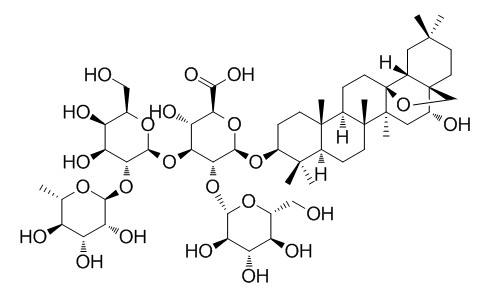Primulic acid I
Primulic acid I shows antibacterial property.
Inquire / Order:
manager@chemfaces.com
Technical Inquiries:
service@chemfaces.com
Tel:
+86-27-84237783
Fax:
+86-27-84254680
Address:
1 Building, No. 83, CheCheng Rd., Wuhan Economic and Technological Development Zone, Wuhan, Hubei 430056, PRC
Providing storage is as stated on the product vial and the vial is kept tightly sealed, the product can be stored for up to
24 months(2-8C).
Wherever possible, you should prepare and use solutions on the same day. However, if you need to make up stock solutions in advance, we recommend that you store the solution as aliquots in tightly sealed vials at -20C. Generally, these will be useable for up to two weeks. Before use, and prior to opening the vial we recommend that you allow your product to equilibrate to room temperature for at least 1 hour.
Need more advice on solubility, usage and handling? Please email to: service@chemfaces.com
The packaging of the product may have turned upside down during transportation, resulting in the natural compounds adhering to the neck or cap of the vial. take the vial out of its packaging and gently shake to let the compounds fall to the bottom of the vial. for liquid products, centrifuge at 200-500 RPM to gather the liquid at the bottom of the vial. try to avoid loss or contamination during handling.
Plants (Basel).2024, 13(19):2793.
Molecules.2017, 22(6)
Molecules.2024, 29(22):5261.
Int J Mol Sci.2023, 24(22):16465.
Microchemical Journal2022, 182: 107874.
Integr Med Res.2017, 6(4):395-403
Journal of Apiculture2023.38(3):249-254.
Acta Agriculturae Scandinavica2015, 381-383
Front Pharmacol.2023, 14:1244655.
Molecules.2018, 23(2)
Related and Featured Products
European Journal of Microbiology & Immunology, 2014, 4(4):204-212.
Saponins increase susceptibility of vancomycin-resistant enterococci to antibiotic compounds.[Reference:
WebLink]
The resistance of commensal bacteria to first and second line antibiotics has reached an alarming level in many parts of the world and endangers the effective treatment of infectious diseases.
METHODS AND RESULTS:
In this study, the influence of the plant-derived natural saponins glycyrrhizic acid, β-aescin, α-hederin, hederacoside C, and primulic acid 1(Primulic acid I) on the susceptibility of vancomycin-resistant enterococci (VRE) against antibiotics of clinical relevance was investigated in 20 clinical isolates. Furthermore, the antibacterial properties of saponins under study against VRE were determined in vitro. Results reveal that the susceptibility of VRE against gentamicin, teicoplanin, and daptomycin was enhanced in the presence of the saponin glycyrrhizic acid. Most importantly, glycyrrhizic acid (1 mg/ml) diminished the minimal inhibitory concentration (MIC) of gentamicin in gentamicin low-level intrinsic resistant VRE from 2 - >8 mg/l to ≤ 0.125-1 mg/l. The adding of β-aescin, α-hederin, hederacoside C, and primulic acid 1 to the antibiotics under study showed, compared to glycyrrhizic acid, less influence on the antibiotic potency. Only glycyrrhizic acid (1 mg/ml) and α‑hederin (0.2 mg/ml) showed weak antibacterial properties against the clinical isolates.
CONCLUSIONS:
Our study points towards a therapeutic potential of saponins in the coapplication with antibiotics for bacterial infections.



